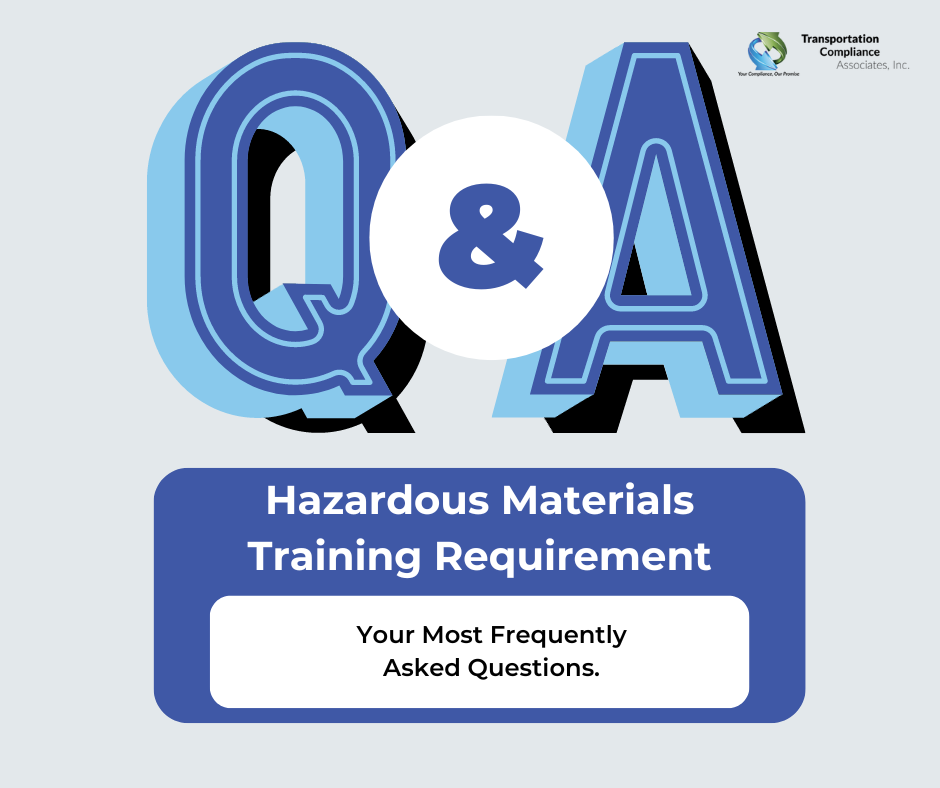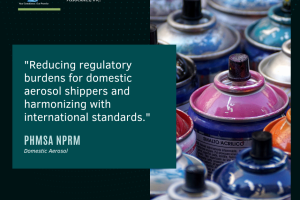PHMSA FAQ Part III

Training Requirements
For those who have been following this series of blogs, you know that the Department of Transportation (DOT) Pipeline and Hazardous Materials Safety Administration (PHMSA) has been releasing what they call their Frequently Asked Questions publications where they take historical letters of interpretation (LOI) applicable to the Hazardous materials Regulations (HMR) and publish them to help the public better understand the HMR. In doing this, PHMSA has taken LOI’s that have been issued to specific stake holders and retranslated them into more broadly applicable FAQs.
Keep in mind, according to PHMSA these “FAQ[s] are not substantive rules themselves and do not create legally enforceable rights, assign duties, or impose new obligations not otherwise contained in the existing regulations and standards.” Now that we got that out of the way, let’s take a look at what PHMSA is trying to help clarify in regard to Hazardous Materials Training.
1. Question: What are the hazardous materials training requirements?
Answer: A hazmat employee, defined under § 171.8, is subject to training under § 172.700. Each hazmat employer must train and test their hazmat employees, certify their training, and develop and retain records of current training. The HMR requires a systematic training program that ensures a hazmat employee has familiarity with the general provisions of the HMR; is able to recognize and identify hazardous materials; has knowledge of specific requirements of the HMR applicable to functions performed by the employee; and has knowledge of emergency response information, self-protection measures, and accident prevention methods and procedures.
2. Question: What is required as part of a complete hazmat training program?
Answer: Section 172.704 requires that hazmat training include:
- general awareness/familiarization training;
- function-specific training;
- safety training;
- security awareness training; and
- in-depth security training if a security plan is required.
Additionally, § 172.700 requires hazmat employees receive modal-specific training for the individual modes of transportation the employee operates.
This training can be performed by the hazmat employer, by the hazmat employee, or by a contracted training service so long as all the training requirements in Subpart H to Part 172 are met.
3. Question: Who is considered a “hazmat employee?”
Answer: A hazmat employee is defined in § 171.8 as any person who—in the course of employment—directly affects hazmat transportation safety and includes, but is not limited to, loading, unloading, or handling hazmat; inspecting hazmat packaging; preparing hazmat shipments; operating vehicles used to transport hazmat; and anyone responsible for hazmat transportation safety.
4. Question: Who is considered a “hazmat employer?”
Answer: A hazmat employer is defined in § 171.8 as a person who uses one or more of its hazmat employees to transport hazmat in commerce; to cause hazmat to be transported in commerce; or designs, manufactures, fabricates, inspects, marks, maintains, reconditions, tests, or repairs containers, drums, or packagings as qualified for use in the transportation of hazardous materials.
5. Question: Do the HMR allow a hazmat employee to self-train?
Answer: Yes. Hazmat employees may self-train, provided the general awareness/familiarization training, function-specific training, safety training, security awareness training, in-depth security training, testing, recordkeeping, and certification requirements specified in § 172.704 are met.
6. Question: What training materials and resources are available from PHMSA?
Answer: PHMSA’s Outreach and Training Branch offers training publications, videos, and brochures, which can be found at: https:// www.phmsa.dot.gov/training/hazmat/hazardous-materials-outreach-engagement.
7. Question: Is a hazmat trainer required to have a certification or minimum level of training?
Answer: No. PHMSA does not specify or require minimum qualifications for hazmat trainers. A trainer needs to be able to convey the training requirements under § 172.704.
8. Question: What documentation or recordkeeping is required for hazardous materials training?
Answer: Hazmat employers must keep training records for each hazmat employee in accordance with § 172.704(d). Compliance with recordkeeping requirements can be achieved in many ways ( e.g., certificate, electronic, or even written paperwork) and could involve partnerships with any organization offering training that meets the needs of the hazmat employer. The training records must include the following information:
- the hazmat employee’s name;
- date of the most recently completed training;
- information about the training materials;
- name and address of the trainer; and
- a certification that the hazmat employee has been trained and tested in accordance with the HMR.
Regardless of who performs the training or generates the records, the hazmat employer is ultimately responsible for compliance with the recordkeeping requirements of § 172.704(d).
9. Question: Is testing of hazmat employees—for example, a test or exam—required as part of a training program?
Answer: Yes. While the HMR do not prescribe detailed test procedures for hazmat employees, some type of test or exam is required. The purpose of testing is to ensure that each hazmat employee has been trained on appropriate areas of responsibility and can perform their assigned duties in compliance with the HMR. (See § 172.702; see also § 172.704.) Any method of testing that achieves this purpose is acceptable. No specific testing document is required.
Although the requirements in § 172.702(d) do not state that a hazmat employee must “pass” a test, a hazmat employee must be trained in accordance with the applicable HMR and may only be certified in those areas in which the hazmat employee can successfully perform their assigned duties. Employees may be tested on the training requirements specified in § 172.704 by any appropriate means.
10. Question: May an employee successfully take a test and have the hazmat training or recurrent training requirement waived?
Answer: No. An employee may not take and pass an exam, and then have the hazmat training or the recurrent training requirement waived. Hazmat training and recurrent training must cover the primary areas as specified under the training requirements in § 172.704, i.e., general awareness/familiarization training, function-specific training, safety training, security awareness training, and in-depth security training (if applicable).
11. Question: How often must a hazmat employee be trained?
Answer: In accordance with § 172.704(c)(2), a hazmat employee must receive the required training at least once every three years.
12. Question: If an employee’s job function changes, and new hazmat functions are performed or PHMSA regulations are amended, is further training required?
Answer: Yes. A hazmat employer must ensure that each hazmat employee is thoroughly instructed in the requirements that apply to functions performed by that employee. (See § 172.702(b).) Section 172.704(c)(1) requires that a new hazmat employee or a hazmat employee who changes job functions must complete their hazmat training within 90 days after employment or job function change. However, they may perform the job functions prior to the completion of training under the direct supervision of a properly trained and knowledgeable hazmat employee. When PHMSA adopts a new regulation or changes an existing regulation that relates to a function performed by a hazmat employee, the hazmat employee must be instructed in the new or revised function-specific requirements as soon as necessary based on the new requirement’s compliance timeline without regard to the three-year training cycle.
13. Question: How does a hazmat employer determine what function-specific training is required under § 172.704?
Answer: Function-specific training is specific to the function(s) for which the hazmat employee is responsible. The hazmat employer must determine what tasks the hazmat employee is responsible for that are directly regulated under the HMR, and then provide the necessary training in accordance with Subpart H to Part 172.
14. Question: Is online, computer-based, and virtual training authorized under the HMR?
Answer: Yes. A hazmat employer may use any type of training method, including forms of digital training ( e.g., online, computer-based, and virtual training programs), that ensures each hazmat employee receives general awareness/familiarization training, function-specific training, safety training, security awareness training, and in-depth security training. (See § 172.704; see also § 172.702.) The hazmat employer must also ensure that testing, recordkeeping, and certification requirements as specified in § 172.704 are met.
15. Question: Can previously completed Occupational Safety and Health Administration (OSHA), U.S. Environmental Protection Agency (EPA), or other required safety training substitute for hazmat training?
Answer: Training conducted to comply with the hazard communication programs required by OSHA, EPA, or training programs required by other federal or international agencies may be used to satisfy portions of the training requirements set forth in Subpart H to Part 172.
16. Question: What are the penalties for violation of the requirements of the HMR, such as training?
Answer: A hazmat employer must ensure that each of its hazmat employees is trained in accordance with the requirements prescribed under Subpart H to Part 172 . (See § 172.702.) A person who knowingly violates a requirement of the HMR or the Federal Hazmat Transportation Law, 49 U.S.C. 5101 et seq., may be liable for a civil penalty of not more than $ 99,756.[6] For a violation that results in death, serious illness, severe injury, or substantial property destruction, the maximum penalty is increased to $ 232,762.6 For violations related to training, there is a minimum penalty of $ 601. (See § 107.329.) Maximum and minimum penalty limitations are updated annually to adjust for inflation.
17. Question: Who is responsible for the required hazmat training of a subcontractor’s employees?
Answer: Under § 171.8, a subcontractor’s hazmat employee is a hazmat employee. In accordance with § 172.702(a), the subcontractor, as the hazmat employer for its hazmat employees, is responsible for ensuring that each of its hazmat employees are trained in accordance with Subpart H to Part 172. However, § 172.702(c) provides flexibility on who can provide the training. The training may be provided by the hazmat employer or by some other public or private source.
18. Question: Is a person located outside the United States who offers a shipment from a foreign location for transportation in the United States—in accordance with an international standard recognized by the HMR—subject to the training requirements in Subpart H to Part 172?
Answer: Yes. § 171.22 prescribes additional requirements for the use of international standards for shipments offered for transportation or transported in the United States and includes shipments originating in a foreign location and transported to the United States. Under § 171.22(g)(2), the training requirements in Subpart H to Part 172, including function specific training, must be satisfied. Training conducted, in accordance with § 171.22, to comply with the international standards may be used to satisfy the training requirements set forth in § 172.704, to the extent that such training addresses the training components specified in § 172.704(a). It is not necessary to duplicate training. However, the hazmat employer must provide additional training to employees performing covered functions for any training components required by the HMR that were not previously addressed.
19. Question: Is a driver required to have hazmat training in accordance with Subpart H to Part 172 if the driver has a hazmat endorsement on a CDL?
Answer: Yes. In accordance with § 177.800(c), each driver who is a hazmat employee is subject to the training requirements in Subpart H to Part 172, and the driver training requirements in § 177.816, regardless of whether a hazmat endorsement is required. However, the training required to obtain a hazmat endorsement may be used to satisfy some of the training requirements of the HMR to the extent that such training addresses the training components of § 172.704. (See § 177.816(c).)
If you found this blog helpful, you may want to check out Part 1 FAQ: Applicability and Part 2 FAQ: Incident Reporting and Notifications on our website. You can also find other shorter blogs covering topics most important to our industry. And don’t forget to follow us on all our social media outlets at Facebook and LinkedIn to be the first to know when new content like this drops. You can also opt-in to our monthly newsletter that offers you even more regulatory news, special offers, and industry insights.
However, if you’re in need of immediate assistance with any regulatory or training needs, you can always contact us directly through our website at www.learnhazmat.com or give us a call at 412.249.1111 for a 100% FREE CONSULTATION and one of our dedicated team members will help you decide what industry leading training or compliance program best fits your budget and needs!
Tag:Hazmat training, HMR, LOI, PHMSA




